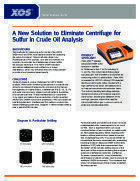Analytical Instrumentation
A New Solution to Eliminate Centrifuge for Sulfur in Crude Oil Analysis
Jul 20 2018
Author: Kyle Kuwitzky - XOS on behalf of XOS
BACKGROUND
Test methods for measuring sulfur content, like ASTM D4294 and ISO 8754, have become critical for assessing the value of crude oil. These methods utilize X-ray Fluorescence (XRF) analysis, and with any method, it is important to consider the interferences inherent within the analysis technique. The ASTM D4294 standard test method references matrix effects as a known interference, which may influence the sulfur measurement in crude oil and produce biased results.
CHALLENGE
Crude oil presents unique challenges for ASTM D4294 analysis. While sulfur containing compounds in crude oil are primarily comprised of organosulfur compounds that remain homogeneous in hydrocarbons, interferences like Si, Ca, Cl, Fe and water are commonly present and will settle to the bottom of a sample over time. These interferences can absorb the X-ray signal and reduce the concentration of sulfur reported. While many D4294 instruments (traditional XRF) can correct for interfering elements, interferences that settle in crude oil can create challenging scenarios. Diagram A demonstrates settling over a period of 60 minutes.
Digital Edition
PIN 25.1 Feb/March
March 2024
In This Edition Safety - The technology behind the ION Science Tiger XT - Safety with ammonia and LOHCs as hydrogen carriers Analytical Instrumentation - Discussion on new tribology te...
View all digital editions
Events
Apr 28 2024 Montreal, Quebec, Canada
Apr 30 2024 Birmingham, UK
May 03 2024 Seoul, South Korea
May 05 2024 Seville, Spain
May 06 2024 Riyadh, Saudi Arabia















